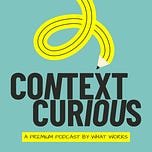I’m hosting a live workshop on Thursday, December 14 at 12:30pm ET/9:30am PT for premium subscribers that dives deeper into the process I share in this post! If you’re not already a premium subscriber, upgrade for just $7/month to attend or view the recording.
Here are a few (I think) obvious truths stated dramatically:
We live in a world of constant change and uncertainty.
Ambiguous anxiety is a chronic (and nearly universal) condition.
There are no sure bets.
No checklists for success.
No blueprints for building a life or career you find fulfilling and satisfying.
You already know all that.
And yet, how many times have we searched aimlessly for a set of instructions that doesn't (and can't) exist? How many times have we let a project fall by the wayside because it didn't go according to plan? How many times have we declined an opportunity or challenge because we didn't know how to do it?
When I asked you about the topics you'd like me to cover in the future, navigating and planning for uncertainty was a big theme. Here's an example of what I mean:
I'd love some down-to-earth "not advice" on how to set goals and make plans when life (and work) keeps throwing curveballs. How do I juggle my dreams and the day-to-day grind without getting burned out? How can I map out a future that's true to who I am while still getting me where I want to be, especially when I'm pulled in a million different directions?
Look, I struggle with this, too. I don't know anyone who doesn't. But I also have thought long and hard about these very questions, and I have ideas.
Goal-setting and planning are difficult for many reasons.
But a critical reason, perhaps the one that leads to the most frustration and trepidation, is the expectation that we have to get it right. Getting it right, we seem to assume, makes it a sure thing. We just need to figure out how to string together the right steps. In the right order. To achieve a particular outcome.
Literally no plan works this way. But that doesn't stop many of us from trying.
We yearn for order in a chaotic world—and the planners, calendars, and bullet journals we use promise to create that order. They are linear. They're chronological. They're full of lines and boxes that stack neatly on top of one another. They ask us to name the tasks we need to complete, assign them due dates, and check them off one by one. They take each project, break it down into steps, and again, and again, until a project is a set of interchangeable parts—rather than a whole.
There's a short passage from Jeannette Winterson's 12 Bytes that I think about often. "Reality is not made of parts but formed of patterns," she writes. "There is nothing solid. There are no binaries. There is energy, change, movement, interplay, connection, relationship." And here's the bit that often comes up for me when I'm trying to wrestle some web of ideas into a more or less solid text:
I would like to start in 2 places simultaneously. Unfortunately. I have to write in series, whereas the great strength of the brain is parallel processing.
Our planners, project management apps, to-do lists, and, by extension, our plans steer us back to the linear, the sequential, and the mechanistic—even though we think and feel in multilayered, interlocking patterns.
So how might our plans change if we gave them a different form? How might we think differently about projects and goals if we put them into a medium other than a calendar or list?
The medium I have in mind is the syllabus.
I've made syllabi for different programs I've taught for years. One of my always-on-the-back-burner projects is making syllabi to share with you about topics like labor theory or feminist economics—just for funsies. I even have an idea for a satirical creative nonfiction project in the form of a curriculum for a "neoliberal" arts degree.
But a couple of years ago, Sean told me that he had made himself a syllabus to follow. He had a syllabus for learning to quilt. He had another one for exploring color theory.
When I mentioned this in a workshop in early 2023, I got tons of requests for his personal syllabus, as well as plenty of requests for him to teach his own workshop. He wasn't ready to share then. But he's since opened up about his process.
Before we get into specifics, let me back up for a minute.
What is a syllabus?
A syllabus is essentially an outline for a class.1 A syllabus typically gives a description of the class, its learning outcome, and the weekly topics and assignments. There's usually information on expectations for class, how classwork will be graded, and what to expect from the teacher or professor.
A syllabus is a compelling medium for a plan because it has both chronological elements and systematic elements. It defines completion in terms of learning rather than any particular achievement. And it connects varied resources to the subject at hand.
Sean's syllabus probably isn't as detailed as one you'd receive before a college course—but the form gives him some space to play with his plans. In the rest of this article, I'll first share how Sean creates his own syllabus. Then, we'll get nerdy with a bit of learning and goal-setting psychology. And then, I'll break down the process with an example to follow along with.
Planning with a syllabus
Sean makes one syllabus per quarter, and right now, he's working on his first-quarter learning goals. His syllabus contains both some high-level habits he wants to keep in focus (e.g., movement and breathwork) and the specific learning projects he wants to work on. Sean has, as he put it, an "infinitely deep bucket" of interests. Realizing that is why he approaches his interests in this way.
"If I don't do that," Sean told me, "I tend to get really scattered and all over the place." Without some structure and focus, he's only able to skim the surface of an interest before he gets distracted by another. Working with a quarterly syllabus allows him to relax a bit—he can focus on a few things for a few months and know that other interests can get scheduled for the next quarter.
















